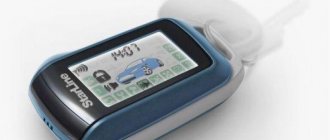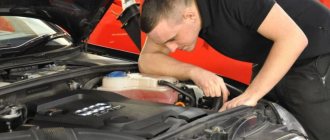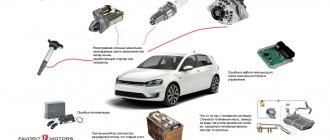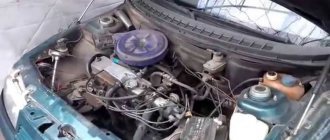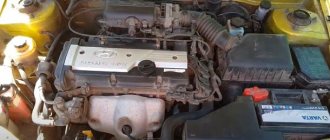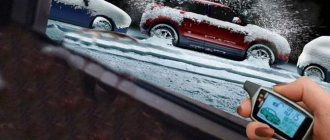Shaking and vibration in a car is dangerous. If you encounter this on the road, it's best to stop and investigate the possible problem. Today we will tell you about all the reasons that can cause your car to vibrate or shake on the road.
Of course, it will be easier to find the cause if you understand the nature of the shaking. If the car shakes in a certain gear, then you should check the transmission. If it starts to shake at a certain rpm level, have the engine checked. But often the problem is different.
We will provide you with a checklist of sorts so that you can easily find the problem and understand whether it is safe to continue driving.
Type of shaking and vibration
To better understand what's going on with your car, you need to check the type of vibration. If your car shakes while driving, there may be a problem with the suspension or wheels. If it vibrates when you start the engine, you need to check the engine - for example, one of the cylinders may not be firing. If your car shakes when braking, it's obvious that you need to check your brake rotors and pads.
Let's start our checklist by going into more detail about what can actually cause your car to vibrate under different conditions.
Balancing
If the wheels are poorly balanced, then the runout on both the body and the steering wheel will in any case manifest itself. Indeed, in this case, the mass relative to the central part of the wheel disk is distributed unevenly, and therefore the centrifugal forces become multidirectional. This creates unpleasant vibrations that are clearly felt inside the car.
This reason for car vibration during acceleration usually manifests itself in several cases:
Installing new tires on old rims or installing new rims on old tires without balancing. After all, ideal weight distribution is quite a difficult task even for the manufacturing plant. Natural imbalance during wheel operation. Therefore, it is advisable to carry out scheduled balancing after 15-20 thousand km. If a car has light alloy wheels, then very often the balancing weights come off of them and simply “sit” on the glue on the inside of the wheel. Another thing is stamped discs, where weights are placed on the outer side of the rim. Deformation of the outer layer of the compound or wheel after hitting a curb, hitting a pothole on the road, etc.
Tire problems
The first reason for shaking in the car is possible problems with the tires. They may have too low or too high pressure. This will cause discomfort when driving on a bad road. A flat tire will cause severe vibration and loss of control. But even if the tire is not flat, but simply underinflated, it can cause vibration, especially at speeds above 60-70 km/h.
Uneven tire wear and defects can also be a problem. You won't feel any problems at low speeds, but once your car reaches a speed of more than 90 km/h, the tires will show their problems. Driving fast is not safe if the tires have defects. Of course, you shouldn't drive with flat tires.
If your tires are bald, you may also experience ride problems. Firstly, it is forbidden to drive on bald tires. Secondly, it is very dangerous. So it’s better to check your tires before the season and buy new ones if the old tires no longer meet the standards.
If the vibration comes from the tires, it is usually felt when you are driving above 60-70 km/h and gets worse as you accelerate. Usually things aren't that bad, but you still feel uncomfortable.
Is it possible to drive with body vibration?
For some motorists, stable vibration in a car is so natural that they get used to it and eventually stop noticing it. But if a similar effect occurs suddenly in a car, you need to immediately look for its cause. Otherwise, the driver risks getting into an accident due to damage to the suspension, chassis or transmission.
You cannot continue driving at high speed, even with the slightest vibration. In addition to discomfort, this effect can provoke other breakdowns of adjacent components and mechanisms of the car. Ignoring minor problems can result in more expensive repairs.
In most cases, vibration elimination can be performed at any service station, and it is not an expensive procedure. It will be much more expensive to eliminate the consequences of damage caused by high-frequency beats.
Wheels
A poorly balanced wheel is one of the most common problems that cause vehicle vibration. You shouldn't have any problems driving around town at low speeds. But once you reach 90 km/h or more, poorly balanced wheels will remind you that they need to be repaired. The car begins to shake intensely after 100-110 km/h, and drivers usually decide to drive slowly so as not to feel the strong vibration.
But be very careful. A poorly balanced wheel can cause problems with the suspension and even the wheel threads. If you notice that your car is shaking at high speeds, it is better to reduce your speed to 60 km/h and change route to the nearest service center.
Also damaged wheels will show exactly the same problems. If the wheel is bent, broken, or changed shape, it is unsafe to drive. It's best to use a spare tire.
Rubber
There are often cases when vibration when accelerating appears due to the installation of low-quality tires. Most often these are tires from budget and extra-budget manufacturers. The peculiarity of such rubber is that when checking on a balancing stand, a discrepancy that causes discomfort when driving a car may not be noticed. In the second case, balancing only temporarily delays the reappearance of vibrations. Only replacing the tires will solve the problem.
The next reason for the appearance of unwanted vibrations is typical for owners whose car is shod with low-profile tires. The side cord of such tires does not have the rigidity and elasticity that is inherent in civilian versions of tires. Therefore, prolonged downtime, especially in the warm season, can cause temporary deformation of the tire at the point of contact with the road surface. Therefore, vibration during acceleration may be observed for a short time after the start of movement. The first kilometers should be covered with extreme caution.
Wheel bolts
If your car starts to shake at low speeds and the vibration becomes unbearable when driving at 60 km/h, it means there is a problem with the wheel bolts or nuts. Stop driving immediately because one of the wheels may simply fall off if you continue driving. Park the vehicle carefully and check the nuts or bolts.
Driving with loose wheel bolts is very dangerous for your health and for the car. Suspension parts can break quickly and the wheel mounting system can fail, so you'll have to spend quite a bit of time and money on repairs. After visiting the service station, it is recommended to check whether the service workers have tightened the bolts well enough.
Other reasons that do not require repair
Even if the vibration of the car when accelerating is very strong, you should not immediately go to the service station and pay a lot of money for car repairs. After all, discomfort when driving can be caused not only by wear or bending of individual suspension components, as well as poor wheel balancing. Very often the cause of the problem is dirt stuck to the rim, ice - the problem manifests itself after off-road driving in the cold season - incorrect installation of the disks and their inconsistency with the mounting dimensions.
In the end, imbalance can occur due to a simple loosening of the discs. Therefore, you just need to monitor your car and identify simple, non-investment causes in time.
Source
Worn supports and CV joints
Failed ball joints will cause shaking and vibration at higher speeds. The CV joints will make a knocking noise when turning sharply. If these parts are broken, it is better to stop driving the car. You can drive carefully to the service station if the station is not that far away, but drive slowly.
Axle shaft joints cause severe vibration when they are completely worn out. If they fall apart, you will not be able to drive the car, since torque will not be transmitted to the wheels. If you hear a particular noise when turning, be prepared to replace your CV joints before they start causing you problems.
Broken suspension parts
If one of the shock absorbers is broken, it can cause shaking. It can also create different types of noise that will indicate to you that there is a problem with your suspension. Vibration can also start if there are problems with the suspension arms or any mounting.
Another possibility is that the suspension mounting points are broken. This can happen to older cars that have a lot of rust on the body. The installation site may rust, so the bolts will not hold up. This will result in you spending a lot of money on body repairs. Vibrations and sounds can be the result of problems with both the front and rear suspension.
The car shakes at idle
If the car vibrates when the engine is idling, then the problem must be looked for in the mounting elements of the internal combustion engine. To eliminate it, you should pay attention to the following possible causes.
- Worn engine mount. During operation of the power unit, vibration is compensated by rubber support pads. The problem won't necessarily be that the part is torn. Over time, the rubber elements become rougher. Therefore, they need periodic replacement.
- Motor malfunction. The piston group should idle as smoothly as possible. If this does not happen, you need to take the car to a mechanic. Among the causes of smoothness problems are clamped valves or worn piston rings.
- Problem with the fuel system. A clogged fuel system leads to uneven operation of the internal combustion engine. If at idle the engine either picks up or slows down, it’s worth checking the entire line. Replacing the fuel filter or repairing the pump can stabilize engine operation.
To diagnose faults on naturally aspirated internal combustion engines, you can use the recommendations of Nail Poroshin:
“Sausage” at idle or “Extra” air
Steering
The steering rack and linkages can also cause vibration and shaking.
If the steering rack is faulty, the steering wheel may shake. Sometimes you may also feel some vibration on the pedals because the pedals and rack are usually mounted on the same metal board.
Rods and lugs can also cause problems. When they break, you will have difficulty moving the car in the desired direction. She will constantly try to change direction and put you in a dangerous situation. Additionally, broken steering parts can cause severe vibration that you will feel in your steering wheel. A certain knocking noise may also be heard. It is dangerous to continue to drive a car if the steering system of the car is faulty.
Wheel alignment
Surprisingly, many car owners are not aware that their cars require special maintenance, which is often missed during regular servicing. Toe and camber should be adjusted at least once a year. It is better to check the wheel angles every six months to ensure that your tires last longer.
Typically, vehicles with misaligned tires exhibit poor handling. Vibration and shaking occur when accelerating to speeds over 100 km/h. With slight changes in angles, the shaking may be barely noticeable.
How to eliminate car vibrations. And why are they dangerous for the car?
Are you familiar with the situation when your car begins to vibrate noticeably after installing new rims? Or when the same problem occurs when installing used tires? Avto.pro explained the dangers of body vibrations and how you can eliminate them yourself.
Why are vibrations dangerous?
The driver may get used to body vibrations and think that this is normal. What if the shaking becomes strong, objects on the dashboard begin to move from side to side, and the picture in the rearview mirror begins to twitch? This is serious
cause for concern. Next, we will try to classify body vibrations and highlight the main reasons for their occurrence, and also outline options for solving problems.
What are the vibrations?
Perceptible vehicle vibrations usually occur when driving at high speed. However, in some cases, drivers encounter a problem even at idle speed right after starting the engine or when increasing the speed before moving off. Let's look at these points in more detail.
Tire wear
It is important for a car enthusiast to be able to read the tread pattern and sidewall. As a rule, tires should be checked before each trip and cleaned of dirt. The vibrations will become stronger and more noticeable the higher the speed of the car. They usually become noticeable at speeds above 50 km/h. The steering wheel will begin to vibrate first.
Problem wheels
If you suspect deformed rims or even problematic tires, get out on the highway and accelerate to 100-120 km/h. If the wheels are unbalanced due to their deformation, vibrations will become clearly noticeable. Inspect both the rims and tires. In case of purchasing used. components, such checks must be especially careful. It is not worth operating a car with problem wheels and tires.
Engine malfunction
A normally running engine will vibrate in any case, but if this affects ride comfort, then the driver should first check the supports and, if necessary, replace the main consumables. Separately, it is worth causing vibrations in an unbalanced engine. The problem here is more serious. The driver will have to contact specialists. You will need to align the shafts, replace the pistons, etc. – expensive diagnostics and repairs.
Problematic brakes
In rare cases, vibrations are caused by a stuck caliper. The caliper itself can be serviced - there are special repair kits and lubricants for this. Pads can be called one of the automotive consumables. They need to be changed when worn. Some pads are hard and over time they “eat away” the brake disc. This is evidenced by the appearance of concentric grooves. The disc may become deformed due to strong temperature changes
and/or become rusty. The worse its condition, the higher the likelihood of vibrations during braking.
Discs with a thin layer of rust, dirt and brake pad marks can be cleaned with a brush. Don't let the latter scare you too much - under extreme heat, some of the friction material of the pad may be imprinted on the surface of the brake disc. However, this also indicates that you installed pads on your car more for a quiet ride than for a sporty one.
Malfunction of electrical appliances
General recommendations
As can be understood from all of the above, vibrations of the car body can occur in a variety of cases. Sometimes they do not even indicate a breakdown of any component - you just need to carry out balancing
and calmly continue driving. Many car enthusiasts eliminate vibrations on their own. Should you contact a car service if you are worried that you will not be able to make repairs yourself? We propose the following algorithm of actions:
Conclusion
Drivers should not ignore the problem of vibrations of the entire body or individual elements of the car. They lead to rapid wear of entire components, which over time will result in expensive repairs. Add to this the reduction in safety and driving comfort, as well as the negative impact on the physical and mental health of the driver and his passengers.
Often the problem is solved by replacing the tires and reinstalling the rims using spacers. Otherwise they are called instep supports and centering rings. But if the vibrations are associated with malfunctions of suspension parts, cardan or engine mounts, then the driver will have to buy spare parts and install them himself or contact specialists. All this is worth the money spent.
If you find an error, please select a piece of text and press Ctrl+Enter .
Source
Engine
The engine may shake on several occasions.
The most common problem occurs when engine mounts and support pads break. You can check this by rocking the engine yourself. If the engine shakes too much, the mounts are worn out. If the engine is shaking and colliding with other parts under the hood of your car, the mounting system needs a complete overhaul.
Problems can also arise when one of the cylinders does not work. This may be the result of troubles such as a burnt piston or a crack in the cylinder block. But usually it's all about the spark plugs or wires.
The electrical system can also cause problems with engine performance. If one of the cylinders is not firing, the engine will shake all the time and it will also lose power.
We explore the engine compartment and engine sounds
If you determine that the vibration is coming from under the hood, most likely the cause will be improper operation of the engine or the mounting points of vibration-loaded elements.
Problems related to internal combustion engines:
- Engine tripping. Many car owners have encountered a situation where, when accelerating or driving under tension, the engine begins to shake, and the thrust is much weaker than before. In this case, comprehensive engine diagnostics is necessary. The problem may be hidden in the ignition system: worn-out spark plugs, GDP, module and other elements, the malfunction of which leads to misfire in one or several cylinders at once. Possible burnout of valves, insufficient fuel pressure, etc. There are so many reasons that the topic deserves separate detailed consideration.
- Engine support cushions. Vibration during acceleration will appear because an increase in engine speed increases the centrifugal forces acting on the car body. When you sharply press the accelerator pedal to the floor, noticeable shocks may be observed. Made of hard rubber, even new cushions will cause vibrations.
Gearbox and clutch drive
It is also worth paying attention to the mounting locations of the gearbox. Perhaps the reason may be hidden inside the gearbox housing. In the case of a manual transmission, for a more accurate diagnosis, you should pay attention to the factors causing vibration or beating. If symptoms only appear at a certain speed limit, try driving it alternately in different gears. For example, if vibration is noticeable at 70 km, first engage 2nd gear, then 3rd (of course, if the gearbox ratios allow). This way, you can more accurately identify the transmission components that cause vibration.
If there is deformation of the input shaft in the gearbox, vibrations will be noticeable when accelerating in any gear.
An unbalanced flywheel can also cause the symptoms discussed. At the same time, it is worth paying attention to the clutch and release bearing.
If the car has an automatic transmission, check the oil level and condition. An indicator that is too low can cause shocks and vibrations.
Exhaust system
Improper mounting of the engine exhaust system can lead to noticeable vibrations in certain engine operating ranges.
Transmission
Again, the transmission mount and support pads should be checked first. Then check the fasteners. If the car shakes during acceleration, or the car accelerates jerkily, check the transmission itself. In robotic transmissions such as Ford Powershift or Volkswagen DSG, the clutch system may be broken. In a traditional automatic transmission, shaking can be a sign that the transmission is about to die. But sometimes an oil change can extend the life of your transmission and help you deal with the problem of shaking and jerking.
Repairing side cuts of tires: in what cases is it possible, how is it done?
Having noticed the first signs, go to the service, carry out diagnostics or look for the reasons on your own. This directly depends on the available skills, experience and resources for carrying out independent repairs. Some reasons are frankly banal and can be easily eliminated without outside help. Others require the mandatory participation of specialists and the use of professional equipment.
Have you ever experienced a shaking car? What caused it and how did you deal with this problem? Share your stories and personal experiences in the comments.
Subscribe, leave reviews, ask relevant questions and tell your friends about our project!
Brake pads and discs
If your car begins to shake or vibrate when braking, the most likely cause is the brake rotor. It may be damaged, worn or bent. Additionally, if the brake pads are worn out, they can cause shaking. In many cars this is easy to check. Just place your finger on the surface of the brake disc and check for damage or scratches. If the disc has a deep groove in the working surface, you may need to replace it.
If your vehicle's brakes cause shaking or vibration, do not drive. It is very dangerous. The brake system requires special inspections every time you service your vehicle.
Wheels do not comply with factory recommendations
A car rim has its own parameters - width, tire mounting diameter, offset, as well as the diameter of the drill, i.e. the circle on which holes are drilled for mounting bolts or studs. For each wheel model, the number of these holes and their diameter are indicated. If the disk parameters are incorrectly selected, the mount will not screw in completely and will not press the wheel tightly to the hub. As a result, the disk has play. If the diameter of the holes drilled does not match, the wheel will also not sit in its place. Of course, it can be planted using physical force. However, the plane of the disk will not coincide with the parameters of the hub. This is not good for the car.
Half shafts
Most cars have two axle shafts that connect the transmission to the wheels. If one of the axles is bent, it can cause major problems and damage. Usually the car starts to shake when you accelerate to a speed of more than 100 km/h. But it all depends on how badly the axle is bent. A damaged axle shaft can easily damage the transmission or create additional suspension problems. If the vibration is strong and you feel it even at low speed, it is better to stop driving. The repairs will not be too expensive or time-consuming, but in this case it is not safe to drive further.
Reasons depending on speed
Experts have introduced a gradation of breakdowns that manifest themselves depending on the speed limit chosen by the driver. The easiest way to find the reasons for car vibration is when driving at speeds up to 40 km/h. If, while turning, the driver hears an unpleasant crunch that penetrates the interior, then most likely this is a faulty CV joint.
However, approximately the same sounds can be produced by such a part of the steering as the rack. And if shaking starts when the gear is changed, this is a clear sign of a gearbox malfunction. In a manual transmission, it can also be caused by wear on the release bearing and friction mechanism. Further, with increasing speed, experts note the following problems.
40-60 km/h
There may already be problems with the cardan mechanism, primarily with the outboard bearing and crosspiece. At the same speed, the vibration can be caused by the exhaust system - its integrity is broken or the fastening is unreliable. And if vibrations are transmitted not only to the body, but also to the steering wheel, then they most likely indicate wheel imbalance.
60-80 km/h
Vibration of the car when driving in this speed range may indicate that there are problems with the braking system. This is indicated by a characteristic sound. Imbalance of the rotating elements of the motor - flywheel, pulleys, fan, etc. - can also lead to an unpleasant effect. The list of potential problems also includes tires whose tread wears out at different rates on different wheels. Finally, simple clogging of the fuel filter, as well as a lack of transmission oil in the automatic transmission, also cause hesitation.
80-100 km/h
Suspension parts begin to contribute to vibration processes when driving at such speeds. Moreover, for the problem to appear, only minor wear, including ball joints, is enough.
It should be noted that this list shows the most likely causes of car vibration when driving. However, there are others. For example, a difference in tire pressure, a slightly bent disk, etc. In addition, the relatively low speed of movement allows the driver to brake or pull to the side of the road in time in the event of an emergency.
And it’s a completely different matter – driving at a cruising speed of 100-120 km, which is practiced by many drivers on country roads. There are many more potential reasons for hesitation here, and they occur more frequently. Therefore, many professionals classify this speed limit as a separate category.
Fuel
Sometimes problems can be caused by the quality of the fuel. For example, if you fill up with diesel instead of gasoline at a gas station, the engine will begin to shake and vibrate, and then may simply stall. If you use low-quality fuel, the fuel filter will immediately become dirty, and it will be quite difficult for the fuel pump to provide the necessary pressure in the system. This can cause low fuel pressure in the fuel injectors, which can cause shaking and vibration.
When overclocking
If body shaking is observed only during acceleration and stops when the speed reaches 80–90 km, the problem should be sought in the operation of the internal combustion engine and fuel system. The cleanliness of the fuel filters and the correct operation of the injectors are checked. Some other causes of the problem:
In 30% of cases, the cause of major repairs is ignoring body vibrations associated with wear of the universal joint.
